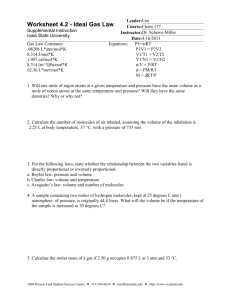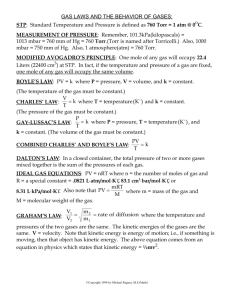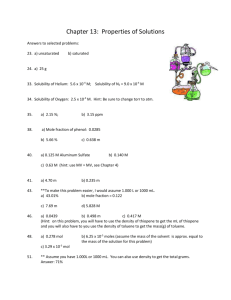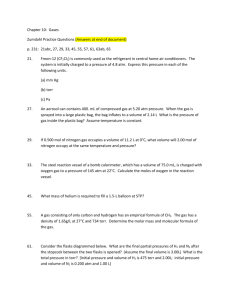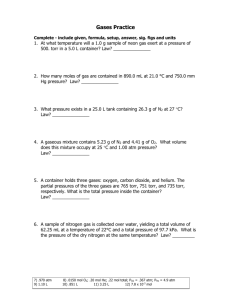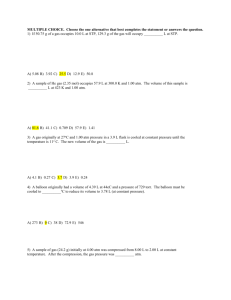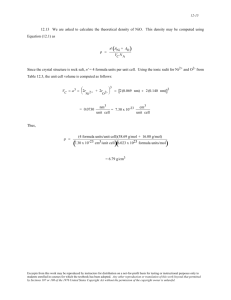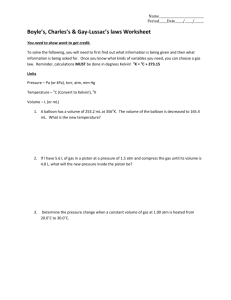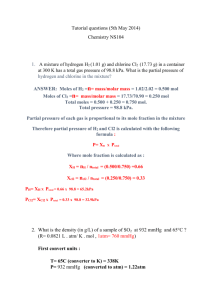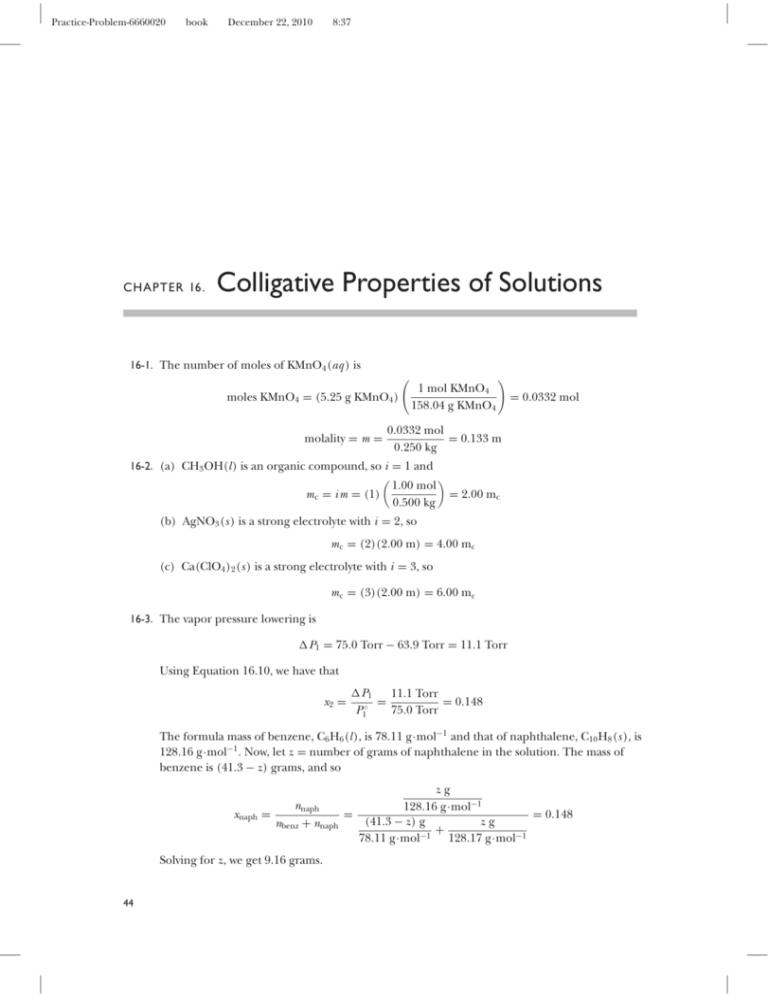
Practice-Problem-6660020
book
CHAPTER 16.
December 22, 2010
8:37
Colligative Properties of Solutions
16-1. The number of moles of KMnO4 (aq ) is
moles KMnO4 = (5.25 g KMnO4 )
molality = m =
1 mol KMnO4
158.04 g KMnO4
= 0.0332 mol
0.0332 mol
= 0.133 m
0.250 kg
16-2. (a) CH3 OH(l) is an organic compound, so i = 1 and
m c = im = (1)
1.00 mol
0.500 kg
= 2.00 mc
(b) AgNO3 (s ) is a strong electrolyte with i = 2, so
m c = (2)(2.00 m) = 4.00 mc
(c) Ca(ClO4 )2 (s ) is a strong electrolyte with i = 3, so
m c = (3)(2.00 m) = 6.00 mc
16-3. The vapor pressure lowering is
P1 = 75.0 Torr − 63.9 Torr = 11.1 Torr
Using Equation 16.10, we have that
x2 =
P1
11.1 Torr
= 0.148
◦ =
P1
75.0 Torr
The formula mass of benzene, C6 H6 (l), is 78.11 g·mol−1 and that of naphthalene, C10 H8 (s ), is
128.16 g·mol−1 . Now, let z = number of grams of naphthalene in the solution. The mass of
benzene is (41.3 − z) grams, and so
xnaph =
nnaph
nbenz + nnaph
Solving for z, we get 9.16 grams.
44
zg
128.16 g·mol−1
=
= 0.148
zg
(41.3 − z) g
+
78.11 g·mol−1
128.17 g·mol−1
Practice-Problem-6660020
book
December 22, 2010
8:37
Chapter 16: Colligative Properties of Solutions
45
16-4. The mole fraction of (NH4 )2 SO4 (aq ) is given by
x(NH4 )2 SO4 =
n(NH4 )2 SO4
n(NH4 )2 SO4 + nH2 O
Because (NH4 )2 SO4 (aq ) is a strong electrolyte, it dissociates completely into NH+
4 (aq ) and
2−
SO4 (aq ) ions. Assume a one kilogram solution. The number of moles of ions in one kilogram
of a 0.70 m (NH4 )2 SO4 (aq ) solution is
moles of ions = (3)(0.70 mol·kg−1 )(1.00 kg) = 2.1 mol
and the number of moles of water is 1000/18.02 g·mol−1 = 55.49 moles. Therefore,
x(NH4 )2 SO4 =
2.1 mol
= 0.0365
2.1 mol + 55.49 mol
From Table 15.7, we see that PH◦ 2 O = 55.4 Torr at 40◦ C. Using Equation 16.10, we have
PH2 O = x(NH4 )2 SO4 PH◦ 2 O = (0.0365)(55.4 Torr) = 2.0 Torr
16-5. Because NaCl(aq ) is a strong electrolyte with i = 2, we have
(2)
mc =
3.5 g NaCl
58.44 g·mol−1 NaCl
0.0965 kg H2 O
= 1.24 mc
Now use Equation 16.13 to write
−1 Tb = K b m c = 0.513 K·mc (1.24 mc ) = 0.64
Therefore, the normal boiling point will be 100.64◦ C.
16-6. We use Equation 16.14 to write
−1
Tf = 5.25 K = (1.86 K·mc )m c
or m c = 2.82 mc . For CaCl2 (s ), i = 3, and so m = 0.941 m.
16-7. We use Equation 16.15 in the form
i=
Tf ◦ − Tf
Kf m
=
5.49 K − 2.96 K
−1
(5.07 K·mc )(1.00 m)
= 0.499
where the freezing point of benzene is 5.49◦ C. Therefore, i = 0.5 or 1/2, a result suggesting the
formation of dimers, (CH3 COOH)2 .
16-8. Because CaCl2 (s ) is a strong electrolyte, we use Equation 16.16 with Mc = 3M to write
= RT Mc = (0.083145 L·bar·mol−1 ·K−1 )(298 K)(3)(0.10 mol·L−1 )
= 7.4 bar
The value and units of depend upon the value of R used.
16-9. Use Equation 16.16 with Mc = M to write
M=
19.0 Torr
=
= 1.02 × 10−3 mol·L−1
RT
(62.3637 L·Torr·mol−1 ·K−1 )(298 K)
Practice-Problem-6660020
46
book
December 22, 2010
8:37
GENERAL CHEMISTRY, FOURTH EDITION | McQuarrie, Rock, and Gallogly
One liter of the solution will contain (1000 mL)
correspondence
0.550 g
50.0 mL
= 11.0 g. Thus we have the
1.02 × 10−3 mol 11.0 g
1 mol 1.08 × 104 g
16-10. We use Equation 16.20 in the notation
◦
◦
◦
+ x benz Pbenz
− Ptol
Ptotal = Ptol
Substituting in the values given, we have
100.0 Torr = 59.2 Torr + xbenz (124 Torr)
or x benz = 0.329. Now
y benz =
Pbenz
(0.329)(183 Torr)
= 0.602
=
Ptotal
100.0 Torr
16-11. We use Equation 16.21 to write
Mgas =
Pgas
1.00 bar
=
= 0.10 M
kh
10 bar·M−1
University Science Books, © 2011. All rights reserved. www.uscibooks.com
Practice-Problem-6660020
book
CHAPTER 17.
December 22, 2010
8:37
Chemical Kinetics: Rate Laws
17-1. See the text.
17-2. The average rate of production of O2 (g) is
rate of reaction =
[O2 ]
(0.28 − 0.16) × 10−2 M
=
= 1.2 × 10−4 M·min−1
t
(20.0 − 10.0) min
17-3. The equation for the reaction is
N2 O5 (g) −→ 2 NO2 (g) +
1
O2 (g)
2
According to the chemical equation, one half of a mole of O2 (g) is produced for every mole of
N2 O5 (g) consumed. Therefore, at t = 70.0 minutes
[N2 O5 ] = [N2 O5 ]0 − 2 [O2 ] = 1.24 × 10−2 M − (2)(0.55 × 10−2 M)
= 1.4 × 10−3 M
[NO2 ] = 4 [O2 ] = (4)(0.55 × 10−2 M) = 0.022 M
17-4. Write
(rate of reaction)0 = k [CH3 N2 CH3 ]0x
where x is the order of the reaction. Dividing the data for run 2 by the data for run 1 gives
3.65 × 10−4
0.913 x
=
2.42 × 10−4
0.604
1.51 = (1.51)x
or x = 1. You obtain the same result using the data from the other runs. To evaluate k, we use
run 2 (arbitrarily) to obtain
k=
(rate of reaction)0
3.65 × 10−4 mol·L−1 ·s−1
=
= 4.00 × 10−4 s−1
[CH3 N2 CH3 ]0
0.913 mol·L−1
17-5. Write
y
(rate of reaction)0 = k [NO]0x [Br2 ]0
47
Practice-Problem-6660020
48
book
December 22, 2010
8:37
GENERAL CHEMISTRY, FOURTH EDITION | McQuarrie, Rock, and Gallogly
Dividing the data for run 2 by the data for run 1 gives
2.25 = (1.50)x
or x = 2. Dividing the data for run 3 by run 2 gives
3.00 = (3.00) y
or y = 1. Thus the rate law is
rate of reaction = k [NO]2 [Br2 ]
We evaluate the rate constant using the data for run 2 (arbitrarily).
k=
(rate of reaction)0
2
[NO]0 [Br2 ]0
=
2.93 × 10−3 M·min−1
= 1.30 × 10−3 M−2 ·min−1
(1.50 M)2 (1.00 M)
and so
rate of reaction = (1.30 × 10−3 M−2 ·min−1 )[NO]2 [Br2 ]
17-6. Use Equation 17.19
fraction =
[A]
−1
= e −kt = e −(0.015 min )(60 min/1 hr)(1.0 hr)
[A]0
= e −0.90 = 0.41
17-7. From Example 17-4, the rate constant of the reaction is 2.20 × 10−5 s−1 . Using Equation 17.20,
the half-life is
t1/2 =
0.693
= 3.15 × 104 s = 8.75 hr
k
The number of half-lives in 35 hours is 35/8.75 = 4.0. Using Equation 17.21, the fraction
remaining after 35 hours (4.0 half-lives) is given by
n 4.0
[A]
1
1
= fraction remaining =
=
= 0.0625
[A]0
2
2
17-8. See the text.
17-9. Use Equation 17.23
N
= ln
ln
N0
0.010N0
N0
= ln(0.010) = −
0.693 t
2.41 × 104 y
Solving for t gives 1.6 × 105 years.
17-10. We use Equation 17.23 with t = xt1/2 , where x is the number of half-lives. Realize that 0.010% of
its original value means that N/N0 = 0.000 10.
0.693
0.693
N
= ln(0.000 10) = −
t =−
xt1/2 = −0.693 x
ln
N0
t1/2
t1/2
Solving for x gives 13 half-lives.
University Science Books, © 2011. All rights reserved. www.uscibooks.com
Practice-Problem-6660020
book
December 22, 2010
8:37
Chapter 17: Chemical Kinetics: Rate Laws
49
17-11. We use Equation 17.27
15.3 disintegration·min−1 ·g−1
= 618 years
t = (8.27 × 10 years) ln
(0.928)(15.3 disintegration·min−1 ·g−1 )
3
17-12. Let’s see whether the reaction is first-order or second-order. The following two figures show
ln([NO2 ]/M) plotted against t (linear for a first-order reaction) and 1/[NO2 ]/M−1 plotted
against t (linear for a second-order reaction). You can see from the figures that the reaction is
second-order.
10
20
t/s
30
40
50
ln([NO2]/M)
–2.0
–2.5
–3.0
–3.5
1/([NO2]/M)
30
25
20
15
10
5
10
20
30
t/s
40
50
We can calculate the value of the rate constant by using the various data sets in Table 17.10 and
averaging. For example, using the data for the t = 10.0 s run (arbitrarily) we obtain from
Equation 17.31
1
1
=
+ k (10.0 s)
0.096 M
0.20 M
or k = 0.54 M−1 ·s−1 . The other data sets give 0.54 M−1 ·s−1 , 0.54 M−1 ·s−1 , 0.53 M−1 ·s−1 , and
0.53 M−1 ·s−1 .
17-13. We are given Ptotal in Table 17.13, so we must first determine PN2 O3 at various time intervals.
Ptotal = PN2 O3 + PNO + PNO2
Because we start with only N2 O3 (g), PNO = PNO2 . Thus,
0
PNO = PNO2 = PN2 O3 − PN2 O3
Practice-Problem-6660020
50
book
December 22, 2010
8:37
GENERAL CHEMISTRY, FOURTH EDITION | McQuarrie, Rock, and Gallogly
0
where PN2 O3 is the initial value of PN2 O3 . Therefore, we have
0
Ptotal = PN2 O3 + 2 PN2 O3 − 2 PN2 O3
0
= 2 PN2 O3 − PN2 O3
or
0
PN2 O3 = 2 PN2 O3 − Ptotal
0
where PN2 O3 = 400 Torr. The following two figures show ln(PN2 O3 /Torr) plotted against t
(linear for a first-order reaction) and (1/PN2 O3 )/10−3 Torr−1 plotted against t (linear for a
second-order reaction). You can see from the figures that the reaction is first-order.
ln(PN2O3 /Torr)
6.0
5.5
5.0
5
10
15
20
15
20
1/(PN2O3 /10 –3 Torr)
t /s
8
7
6
5
4
3
5
10
t /s
We can calculate the value of the rate constant by using the various data sets in Table 17.13 and
averaging. For example, using the data for the t = 5.0 s run (arbitrarily) we obtain from
Equation 17.18,
ln
2 PN◦ 2 O3 − Ptotal
PN◦ 2 O3
= ln
(800 − 504) Torr
= −k (5.0 s)
400 Torr
or k = 0.060 s−1 . The other runs give 0.060 s−1 , 0.060 s−1 , and 0.060 s−1 , or 0.060 s−1 to two
significant figures.
17-14. We use Equation 17.35 with PC◦5 H6 = 500 Torr and k = 7.16 × 10−5 Torr−1 ·s−1 :
t1/2 =
1
1
= 27.9 s
=
k PC◦5 H6
(7.16 × 10−5 Torr−1 ·s−1 )(500 Torr)
University Science Books, © 2011. All rights reserved. www.uscibooks.com
Practice-Problem-6660020
book
CHAPTER 18.
December 22, 2010
8:37
Chemical Kinetics: Mechanisms
18-1. See the text.
18-2. Using Figure 18.3 as a guide, we see that the value of the activation energy in the reverse
direction is 80 kJ·mol−1 + 50 kJ·mol−1 = 130 kJ·mol−1 .
18-3. The time, t, for an egg to boil is inversely proportional to the value of the rate constant at that
temperature. The larger the rate constant, the less time it takes to boil the egg. Using
Equation 18.9, we have
ln
k100◦ C
t92.2◦ C
(42 × 103 J·mol−1 )(373.2 K − 365.4 K)
= ln
≈
k92.2◦ C
t100◦ C
(8.3145 J·mol−1 ·K−1 )(373.2 K)(365.4)
= 0.29
or
t92 = t100 e 0.29 = (3.0 min)(1.34) = 4.0 min
18-4. The slow step controls the overall rate of reaction, and being an elementary step, we see that
rate of reaction = k1 [Fe2+ ] [HNO2 ]
18-5. Step (2) controls the overall rate of reaction
rate of reaction = k2 [NO] [NO3 ]
We can eliminate [NO3 ], an intermediate species, using Step (1)
[NO3 ] =
k1
[NO] [O2 ]
k−1
Substituting this expression into the rate expression for step 1 yields
rate of reaction =
k1
k2 [NO]2 [O2 ] = k[NO]2 [O2 ]
k−1
which is consistent with the experimentally determined rate law.
51
Practice-Problem-6660020
52
book
December 22, 2010
8:37
GENERAL CHEMISTRY, FOURTH EDITION | McQuarrie, Rock, and Gallogly
18-6. Start with (see Example 18-6) where 2 is the catalyzed reaction and 1 the uncatalyzed reaction
E a2
+ ln A2
RT
E a1
ln k1 = −
+ ln A1
RT
ln k2 = −
Assume that A1 = A2 and subtract to get
ln
E a1 − E a2
k2
E
5.00 × 103 J·mol−1
=
=
=
k1
RT
RT
(8.3145 J·mol−1 ·K−1 )(298.2 K)
= 2.02
or
k2
= e 2.02 = 7.5
k1
18-7. We must first make a table of 1/R and 1/[S]
(1/R)/mM−1 ·s
(1/[S])/mM−1
41.6 27.8 18.9 16.7
15.6
0.40 0.20 0.10 0.067 0.050
A plot of 1/R against 1/[S] is a straight line.
(1/R)/mM –1·s
40
35
30
25
20
0.2
0.3
(1/[S])/mM –1
0.1
0.4
Using the second and third data sets (arbitrarily), we calculate the slope to be
slope =
−8.9 mM−1 ·s
KM
18.9 mM−1 ·s − 27.8 mM−1 ·s
=
= 89 s =
−1
−1
−1
0.10 mM − 0.20 mM
−0.10 mM
Rmax
by Equation 18.32. The intercept is about 12 mM−1 ·s, so
1
Rmax
= 12 mM−1 ·s
and so Rmax = 0.083 mM·s−1 and K M = 7.4 mM. We used just two data points to determine the
slope. A more sophisticated treatment of the linear plot gives Rmax = 0.085 mM·s−1 and
K M = 6.4 mM.
University Science Books, © 2011. All rights reserved. www.uscibooks.com
Practice-Problem-6660020
book
CHAPTER 19.
December 22, 2010
8:37
Chemical Equilibrium
19-1. From the stoichiometry of the chemical equation, we have
change in moles
per liter of SO2
2 mol SO2
=
1 mol O2
(3.500 − 0.075) mol O2
2 mol SO2
=
1L
1 mol O2
moles per liter
of O2 reacted
= 6.850 mol·L−1
Therefore;
[O2 ]eq = 0.075 M
[SO2 ]eq = 8.500 M − 6.850 M = 1.650 M
[SO3 ]eq = 5.575 M + 6.850 M = 12.425 M
19-2. See the text. Recall that species in a liquid or solid state do not enter the equilibrium-constant
expression.
19-3. From the data given, we can construct the following concentration table
Concentration 2 SO2 (g) +
O2 (g)
Initial
Change
Equilibrium
6.00 M
3.00 M
2 SO3 (g)
1.00 M
+0.40 M
1.40 M
Because the change in [SO3 ] is +0.40 M, we have that the change in [SO2 ] to reach
equilibrium is −0.40 M, and that of [O2 ] is −0.20 M. Thus, the final concentration table is
Concentration 2 SO2 (g) +
Initial
Change
Equilibrium
And so,
Kc =
3.00 M
−0.40 M
2.60 M
O2 (g)
6.00 M
−0.20 M
5.80 M
2 SO3 (g)
1.00 M
0.40 M
1.40 M
[SO3 ]2
(1.40 M)2
=
= 0.0500 M−1
[SO2 ]2 [O2 ]
(2.60 M)2 (5.80 M)
53
Practice-Problem-6660020
54
book
December 22, 2010
8:37
GENERAL CHEMISTRY, FOURTH EDITION | McQuarrie, Rock, and Gallogly
19-4. We use Equation 19.18
K p = K c (RT)νgas = K c (RT)−1 = 25 atm−1
K c = (25 atm−1 )(0.08206 L·atm·mol−1 ·K−1 )(1020 K) = 2.1 × 103 M−1
19-5. We set up a concentration table
Concentration
Initial
Change
Equilibrium
+
2 S(g)
0.700 M
−2x
0.700 M − 2x
C(s ) −
−
−
CS2 (g)
0M
+x
x
Now write
Kc =
[CS2 ]
x
=
= 9.40 M−1
2
[S]
(0.700 M − 2x)2
Put this in the standard form of a quadratic equation:
37.6 M−1 x 2 − 27.3x + 4.61 M = 0
Solving for x gives 0.266 M and 0.467 M. We reject the 0.467 M root because [S] would be
negative. Therefore [CS2 ] = 0.266 M.
19-6. We set up a pressure table
C(s ) +
Pressure
Initial
Change
Equilibrium
−
−
−
CO2 (g)
2 CO(g)
0.22 atm
−x
0.22 atm − x
0
+2x
2x
Now write
K p = 1.90 atm =
or
4x 2
(2x)2
=
0.22 atm − x
0.22 atm − x
4x 2 + 1.90 atm x − 0.418 atm2 = 0
Solving for x gives 0.164 atm and −0.639 atm. From the stoichiometry of the reaction, x must
be a positive number, so we reject the negative value. Therefore,
PCO2 = 0.22 atm − 0.164 atm = 0.06 atm
PCO = (2)(0.164 atm) = 0.33 atm
Ptotal = PCO2 + PCO = 0.06 atm + 0.33 atm = 0.39 atm
19-7. (a) The equilibrium-constant expression tells us that
PNH3 PHI = 18 bar2
PNH3 = PHI , and so PNH3 = 4.24 bar. The total pressure is
Ptotal = PNH3 + PHI = 8.5 bar
(b) In this case,
PNH3 PHI = (5.0 bar + x)(x) = 18 bar2
University Science Books, © 2011. All rights reserved. www.uscibooks.com
Practice-Problem-6660020
book
December 22, 2010
8:37
Chapter 19: Chemical Equilibrium
55
where x is the equilibrium pressure of HI(g). Solving for x gives 2.4 bar and −7.4 bar. We
obviously reject the second root, so that
PHI = 2.4 bar
PNH3 = 5.0 bar + 2.4 bar = 7.4 bar
Ptotal = 7.4 bar + 2.4 bar = 9.8 bar
19-8. (a) In this case, the concentration table is
Concentration
Initial
Change
Equilibrium
+
H2 (g)
0.500 M
−x
0.500 M − x
Cl2 (g)
0.500 M
−x
0.500 M − x
2 HCl(g)
0.500 M
+2x
0.500 M + 2x
Using the equilibrium-constant expression gives
(0.500 M + 2x)2
= 2.5 × 10−4
(0.500 M − x)2
or
0.500 M + 2x
= ±0.0158
0.500 M − x
giving x = −0.244 M or −0.256 M. The concentration of HCl(g) must be a positive quantity, so
we reject the −0.256 M root. Therefore,
[H2 ] = [Cl2 ] = 0.744 M
[HCl] = 0.012 M
As a check,
(0.012 M)2
[HCl]2
= 2.6 × 10−4
=
[H2 ] [Cl2 ]
(0.744 M)2
(b) See the text.
19-9. The equation
1
SO2 (g) + O2 (g) SO3 (g)
2
is 1/2 of the reverse of
2 SO3 (g) 2 SO2 (g) + O2 (g)
so
1
= 1.9 atm−1/2
(0.29 atm)1/2
19-10. (a) Decreasing [CO] will drive the reaction to the right, and so [CO2 ] decreases.
(b) Changing the amount of C(s ), a solid, has no effect on the equilibrium.
Kp =
◦
19-11. The value of Hrxn
for the reaction as written is
1
◦
Hrxn
= Hf◦ [SO3 ] − {Hf◦ [SO2 ] + Hf◦ [O2 (g)]}
2
= (−395.7 kJ·mol−1 ) − {(−296.8 kJ·mol−1 ) + 0 kJ·mol−1 }
= −98.9 kJ·mol−1 < 0
Practice-Problem-6660020
56
book
December 22, 2010
8:37
GENERAL CHEMISTRY, FOURTH EDITION | McQuarrie, Rock, and Gallogly
◦
Because Hrxn
< 0, the reaction is exothermic. Therefore, a decrease in temperature will shift
the equilibrium to the right, increasing the production of SO3 (g).
19-12. The equation for the reaction can be written as
SbCl3 (g) + Cl2 (g) SbCl5 (g)
Using the data given, the value of K p is
Kp =
PSbCl5
0.228 bar
=
= 0.777 bar−1
PSbCl3 PCl2
(0.670 bar)(0.438 bar)
We set up the concentration table with the initial pressures halved because we have doubled the
volume of the container.
Pressure
+
SbCl3 (g)
Initial
0.335 bar
Change
+x
Equilibrium 0.335 bar + x
Cl2 (g)
0.219 bar
+x
0.219 bar + x
SbCl5 (g)
0.114 bar
−x
0.114 bar − x
Using the equilibrium-constant expression, we have
0.114 bar − x
= 0.777 bar−1
(0.335 bar + x)(0.219 bar + x)
or
0.777 bar−1 x 2 + 0.430x + 0.057 bar = 0.114 bar − x
or
0.777 bar−1 x 2 + 1.430x − 0.057 bar = 0
The two roots are x = 0.0390 bar and −1.88 bar. We reject the second root because [SbCl3 ] and
[Cl2 ] must be positive quantities. Therefore,
PSbCl3 = 0.335 bar + 0.0390 bar = 0.374 bar
PCl2 = 0.219 bar + 0.0390 bar = 0.258 bar
PSbCl5 = 0.114 bar − 0.0390 bar = 0.075 bar
Note that the equilibrium position shifts from right to left, in accord with Le Châtelier’s
principle.
19-13. In this case,
2
QP =
PCO
PCO2
=
(485 Torr)2
= 1570 Torr
150 Torr
and
QP
1570 Torr
=
>1
Kp
1.93 Torr
Because Q P /K p > 1, the reaction will proceed from right to left until Q P = K p .
University Science Books, © 2011. All rights reserved. www.uscibooks.com

